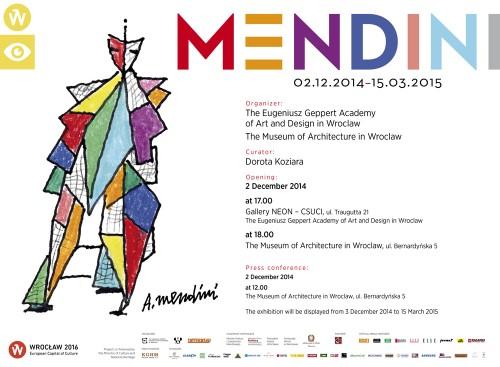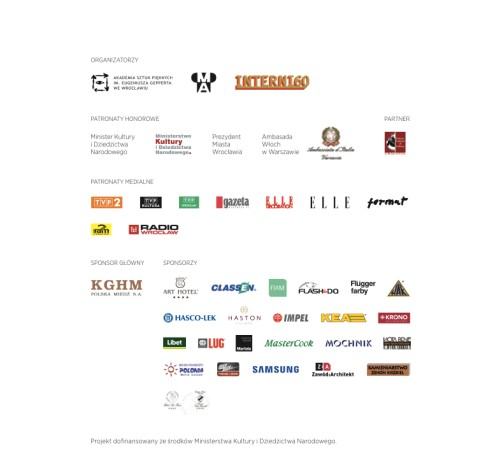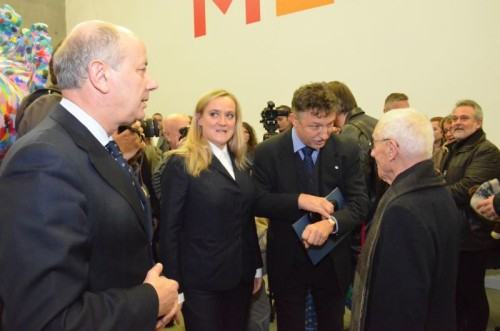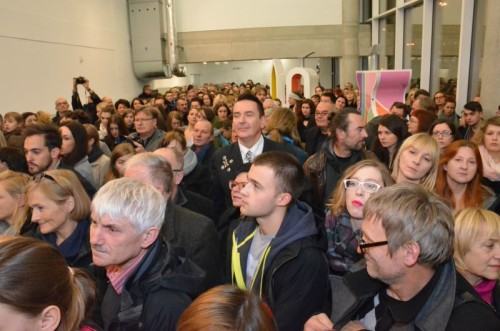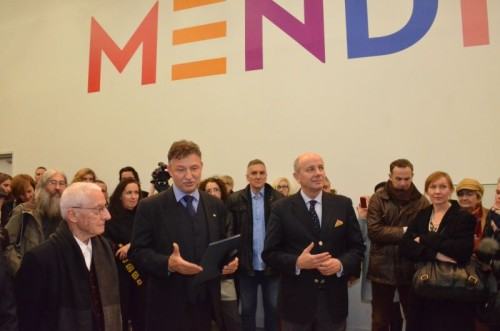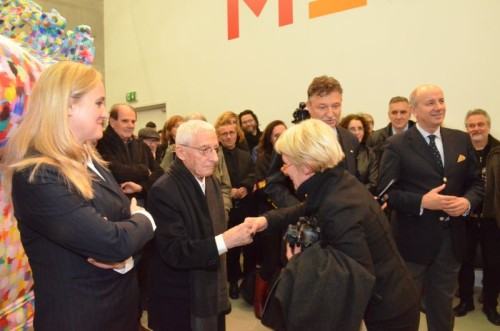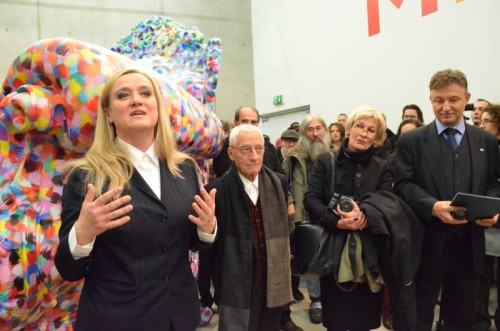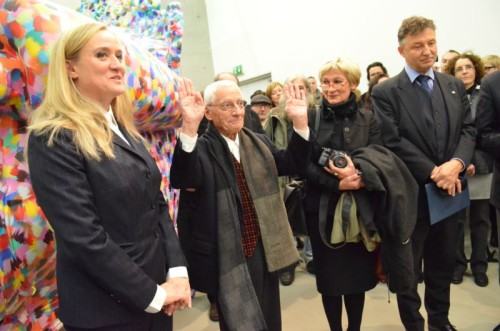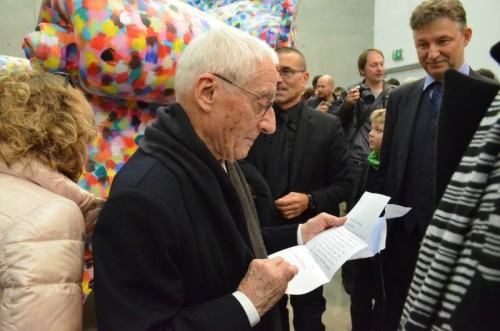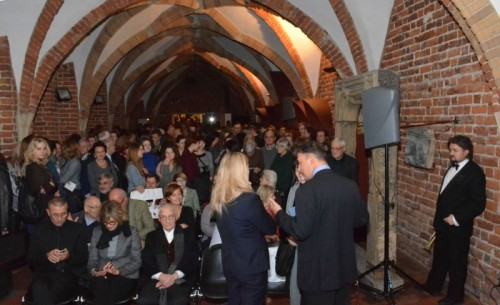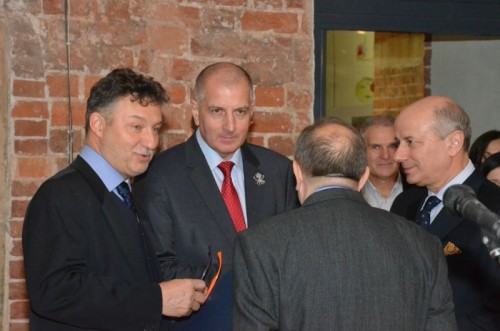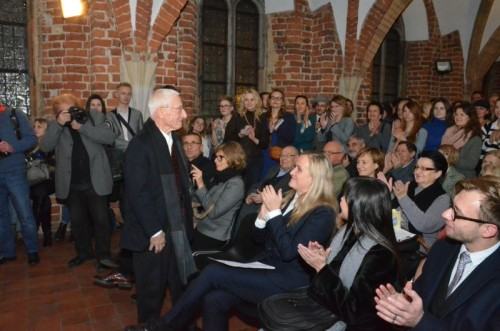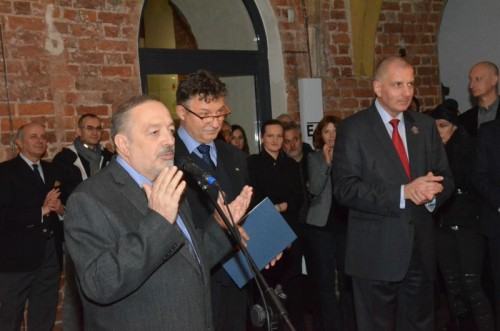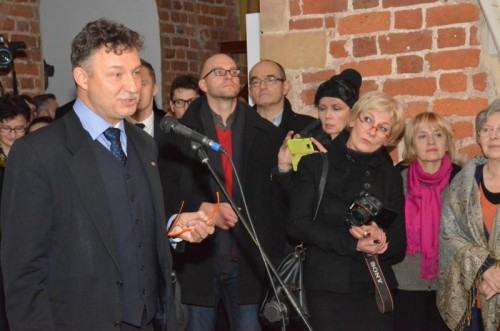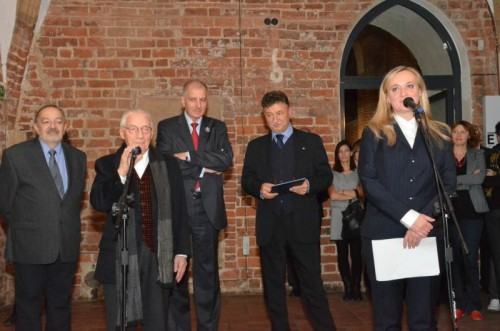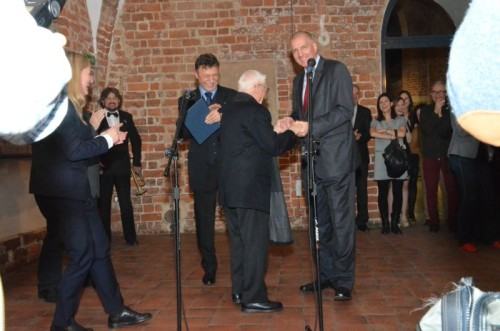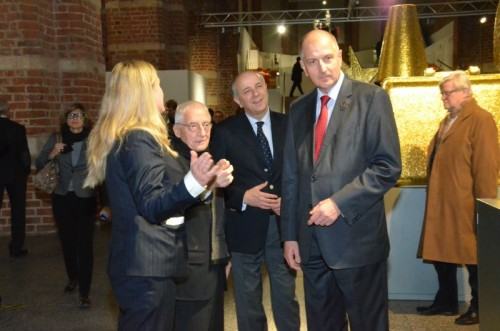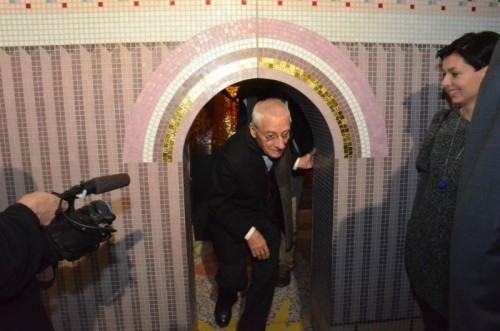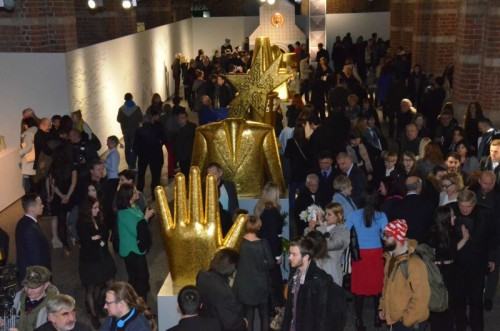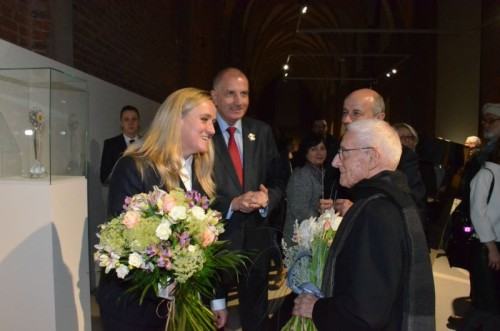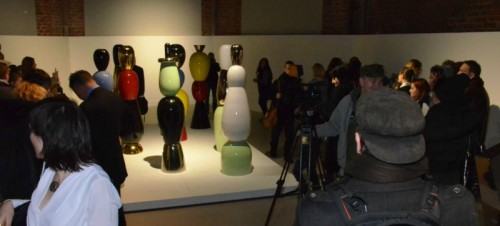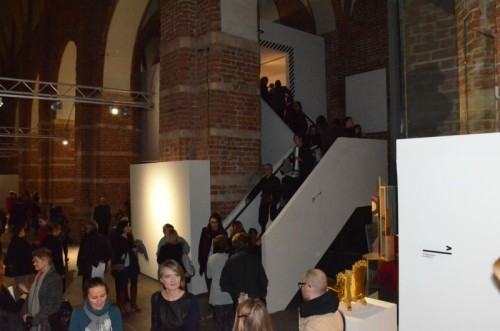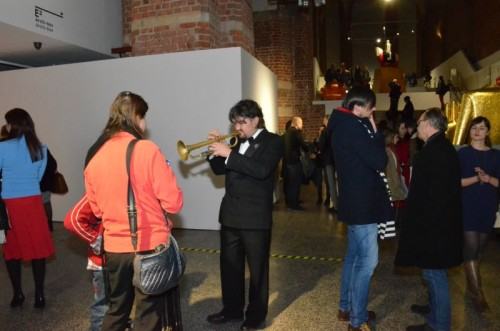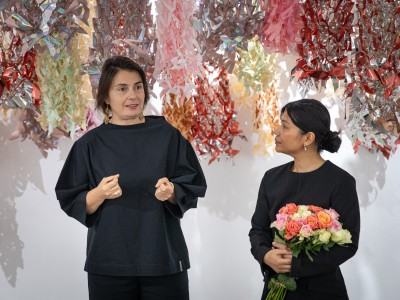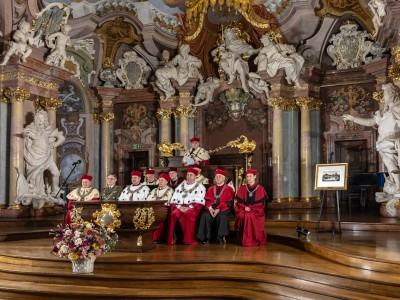
Maestro del Design
MENDINI
Curator/Art Director
Dorota Koziara
Organizers
The Eugeniusz Geppert Academy of Art and Design in Wroclaw
The Museum of Architecture in Wrocław
***
The official Doctor Honoris Causa bestowal ceremony
1 December 2014
at 11.00
Aula Leopoldina, University of Wrocław
Plac Uniwersytecki 1
.
Press conference
2 December 2014
at 12.00
The Museum of Architecture in Wrocław
Bernardyńska 5
.Official opening of the exhibition
2 December 2014
at 17.00 pm
Neon Gallery, The Eugeniusz Geppert Academy of Art and Design in Wrocław
Traugutta 21
at 18.00
The Museum of Architecture in Wrocław
Bernardyńska 5
The exhibition will be displayed from 3 December 2014 to 15 March 2015
.Meeting of Alessandro Mendini with students
3 December 2014
at 12.00
Audiovisual Room, The Eugeniusz Geppert Academy of Art and Design in Wrocław
Traugutta 21
***
The first days of December 2014 will be very special for Wrocław. The exhibition of Alessandro Mendini's works in the Museum of Architecture and the Neon Gallery of the Centre of Applied Art – Innovation Center (the new building of the Academy of Art and Design in Wrocław) will be part of the visual arts programme of the European Capital of Culture 2016. The rich programme will be an opportunity to become familiar with the works of the world-famous architect, designer, design master, critic and chief editor of magazines devoted to architecture, design and art, long-standing director of the world's oldest design magazine, Domus.
The organizer of the exhibition is the Eugeniusz Geppert Academy of Art and Design in Wrocław working in partnership with the Museum of Architecture in Wrocław, the only museum of architecture in Poland. The Curator and Art Director of the event is Dorota Koziara, a designer and artist from Lower Silesia (with its capi- tal in Wrocław), a long-time collaborator of Atelier Mendini who works in Milan running her own studio. Her works will be presented next year. The opening of the exhibition will take place on 9 October 2014 in the halls of the Municipal Office in Wrocław. The MENDINI exhibition has been organized in cooperation with INTERNI MAGAZINE, one of the most important professional magazines on modern design celebrating this year its 60th anniversary. The multidimensional exhibition of Alessandro Mendini's works will be the first such exhibi- tion to be organized by a state art school. On 1 December 2014 inside the grand interiors of Aula Leopoldina of the University of Wrocław, the Eugeniusz Geppert Academy of Art and Design in Wrocław, represented by Rector Professor Piotr Kielan, Ph.D. (Habil.), shall bestow on Mr Allessandro Mendini the prestigious academic title of Doctor Honoris Causa. The promotor in the award proceedings is the Dean of the Faculty of Interior Architecture and Design, Urszula Smaza-Gralak, Ph.D. (Habil.). The President of Wrocław, on behalf of the Municipal Office, asked Mr Alessandro Mendini to design an outdoor sculpture to be located in the city space. A model selected from a few submitted concepts shall be presented during the opening of the exhibition in the Museum of Architecture.
The Wrocław exhibition will feature sculptures and installations, architectural and industrial projects as well as other unique works of the great architect. These include a collection borrowed from Fondation Cartier pour l'art contemporain in Paris comprising such installations as Petite Cathedrale, Grande Poltrona di Proust, Cava- liere sculpture and other objects. Among exhibits from the Groninger Museum in the Netherlands designed by Atelier Mendini (which is in possession of the largest collection of Alessandro Mendini's works) we will be able to see: Tete Gèante and a collection of laminates designed by Mendini for the Italian company Abet Laminati, which have revolutionized the world of contemporary architecture. We will also see nine two-meter tall golden mosaic sculptures, Mobili per Uomo, from the collection of Fondazione Bisazza – a contemporary art founda- tion established by one of the largest manufacturers of glass mosaic in the world, Bisazza, for which Atelier Mendini has worked for many years developing the colour palette of mosaics and collections, and where Ales- sandro Mendini himself was Art Director. Mobile Venice, from the private collection of Cleto Munari, will come Wrocław. The Museum of Architecture will also exhibit a number of miniatures, bronze objects from the Short Stories collection, as well as ceramic Colonne sculptures from the collection of Superego – two-meter tall, colourful objects, resembling anthropomorphic forms.
Atelier Mendini will provide a vast collection of unique objects: the famous Poltrona Proust armchair in its different variants, furniture from the Redesign series, which in the 80s revolutionized the world of design, a ceramics collection made in the traditional Korean Celadon technique, a series of papier-mâche vases, a special social project realized in collaboration with prisoners from one of the largest prisons in Italy, Rebbibia, the Proust series of items and objects including the famous Oggetto Banale Proust, and many other works of the Master.
The Museum of Architecture will also present a series of models of architectural objects realized in different places in the whole world – including such projects as the Groninger Museum in the Netherlands, Torre in Hiroshima, Japan, Alessi Factory in Italy, and many others. Around 60 photographs of the completed architec- tural projects will also be presented. From Triennale in Milan, the most important Italian institution in the field of design and architecture, Wrocław will receive original sketches related to many projects connected with architecture, design and art. Triennale has been in possession of all Mendini's sketches for a few years now. The Wrocław exhibition will also see the typical of Mendini great combination of art and industry embodied by large scale objects – public space sculptures: lamps, vases and seats produced by the Schoenhuber Franchi and Slide companies. Four-meter tall Bomarzo sculptures produced by Schoenhuber Franchi will be featured in the spaces and galleries of the Academy of Art and Design in Wrocław, while the objects Here, There, Glace, produced by Slide, will be shown in the Museum of Architecture.
Alessandro Mendini has often worked as art director for numerous brands. Effects of such cooperation will be shown in Wrocław, i.e. projects made for companies for which collaboration with Alessandro Mendini meant reaching a leading role in the field of design and setting new directions in design. These include: Alessi, Bisaz- za, Swatch and those with whom Alessandro Mendini has worked as a designer for years: Venini, Abet Lami- nati, Magis, Olivari, Porro, Ramun, Swarovski, Zerodisegno, and many more.
The Wrocław exhibition will be a summary of life's artistic work of the great promoter of the art of design and an intellectual of our times. It will present mostly novelties, projects completed over the last 10 years. The exhibition will also be a great opportunity to present to a wide, multinational audience the city of Wrocław – the European Capital of Culture 2016. It will also be a chance for the people of Wrocław to get to know the figures of Alessandro Mendini and Francesco Mendini who, many years ago, founded Atelier Mendini. The Wrocław exhibition will also be an opportunity for jubilee summaries for many institutions and companies of international renown with whom Mendini has worked for years. Among them, the Groninger Musem in the Netherlands celebrating this year its 20th anniversary (whose project was realised in Atelier Mendini) and Foundation Cartier pour l'art contemporain celebrating its 30th anniversary. The famous Anna G collection of Alessi, designed by Mendini, also celebrates its 20th anniversary, and Interni Magazine, one of the world's most important magazines in the field of design, celebrates its 60th jubilee.
The organizers of the Mendini exhibition are the Eugeniusz Geppert Academy of Art and Design and the Mu- seum of Architecture in Wrocław. The
***
The Eugeniusz Geppert Academy of Art and Design in Wrocław educates students in many art and design areas, such as: painting, sculpture, photography, printmaking, graphic design, multimedia, interior architecture, industrial design. The school also runs the unique in Poland design of ceramics and glass programme and a transport design workshop. Its graduates often become head designers in big automobile companies owning famous brands. With the Alessandro Mendini exhibition, the Academy of Art and Design in Wrocław will launch the programme of great events promoting design in Poland. This year, for the first time, the achievements of the Academy's staff and students have been presented in Dorota Koziara Studio/Gallery during Salone del Mobile 2014 in Milan. The exhibition was organized in collaboration with the Consulate of the Republic of Poland in Milan.
In its 60-year long history the Academy has become a significant opinion-forming centre. It is an organizer of ‹4 annual competitions which aim at promoting valuable artistic phenomena, i.e.: the Eugeniusz Geppert Contest, National Young Painters' Exhibition and International Drawing Contest – a continuation of Drawing Triennial.
Since 1991 the Eugeniusz Geppert Academy of Art and Design has been publishing the Format quarterly. Thanks to the efforts of Andrzej Saj, its editor-in-chief, Format has become one of the best professional maga- zines in the field of contemporary visual arts in Poland. In 2012 a new ultramodern building of the Academy was commissioned – the Centre of Practical Art – the Innovation Centre, which serves both educational as well as workshop functions. The building is equipped with state-of-the-art technologies and facilities. It features 9 laboratories as well as 42 lecture and workshop rooms, including glassworks.
The only Museum of Architecture in Poland has been operating in Wrocław since 1965. It is located in the Gothic interiors of a former Bernardine monastery of the 15th century, which comprises the Church of St. Ber- nardine of Siena and a monastery quadrangle building enclosing a patio. It is one of the most precious monu- ments in Wrocław as it is one of the few medieval buildings of this type preserved in Silesia. The arrangement of the buildings of the former monastery has remained unchanged. It is located on the crossing of the main tourist routes, in the very center of Wrocław, and is an important element of the cultural landscape of the city. The mission of the Museum of Architecture is to promote and preserve historical values and testimonies of the old and modern architecture, the life and work of architects and architecture-related arts. The Museum realized these tasks through the exhibiting and publishing activity, research, gathering, dissemination and de- velopment of collections. The Museum of Architecture is also an acknowledged place for meetings, exchange of thoughts and ideas in the field of contemporary architecture. This is achieved, among others, through the cyclic presentations in the Gallery of One Project and Archi-Box. The Museum is a founding member of the International Confederation of Architectural Museums (ICAM) and the seat of the Polish branch of DOCO- MOMO. The museum is also a publisher of numerous publications in the field of architecture devoted to the famous creators and artists, such as: Max Berg, Hans Poelzig, Erich Mendelsohn, Erns May, Jadwiga Grabows- ka-Hawrylak, Stanisław Fiszer, Heinrich Lauterbach, Stefan Müller, and their works.
***
WROCŁAW – EUROPEAN CAPITAL OF CULTURE 2016.
The city is situated in Eastern Europe on the Odra River. It is a historical capital of Lower Silesia. In 1948 the city hosted the World Congress of Intellectuals for Peace. Wrocław has been elected the European Capital of Culture 2016, World Book Capital 2016 and the host of European Film Awards 2016.
The complex history of this city, enriched additionally by the immigration of the people from the Eastern Bor- derlands, has made Wroclaw one of the richest in history and architecture cities in Poland. Wrocław's multicul- tural nature can be sensed in the city's atmosphere. The rich history and exceptionally dynamic development of the university and other schools of higher education in the last decade have made Wrocław recognisable as one of the most interesting and buoyant academic centres in Poland. Wrocław also had strong connections with Bauhaus, the famous design school. Some Bauhaus professors were at the same time teachers in the Academy of Fine Arts in Wrocław (Breslau). One of them was Oskar Schlemmer, the creator of Triadic Ballet. Wrocław is also host of many important cultural events, music and film festivals, e.g.: Wratislavia Cantans, Jazz nad Odrą, T-Mobile New Horizons and American Film Festival, International Theatre Festival Dialog, Brave Festival or Festival of Visual Arts WRO. Wrocław is home to the Jerzy Grotowski Institute, whose patron Jerzy Grotowski created the Laboratory Theatre. Also Henryk Tomaszewski's Pantomime Theatre operates here. Thus, not without a reason, the city's slogan is: 'Wrocław – the meeting place'. It is not incidental that it has earned the title of the European Capital of Culture 2016.
***
ALESSANDRO MENDINI
ALESSANDRO MENDINI an architect born in 1931 in Milan. Maestro del design. Mendini has run magazines on architecture, design and art: Casabella, Modo and the oldest magazine Domus, which he ran again recently. Many books in many languages have been devoted to his activity. He is the creator of Alchimia Group, which has revolutionized the way people think about contemporary design.
His professional interests include architecture, design and art. He collaborates with famous companies in the field of design, such as Alessi, Philips, Cartier, Bisazza, Swatch, Hermés, Venini, Trend, Abet Laminati, where he often holds the position of art director and consultant. He also acts as a consultant and an art director for many industrial brands, also in the Far East, where in the recent years he has been working on image creation and developing of directions in industrial design. He is a honorary member of Bezabel Academy of Arts and Design in Jerusalem. In 1979 and 1981 he received the prestigious Compasso d'Oro award in design and the title Chevalier des Arts et des Lettres in France. He was also awarded the Architectural League of New York distinc- tion and the Doctorate Honoris Causa from the Polytechnic University of Milan.He taught design at Hochschule für Angewandte Kunst in Vienna and is an honorary professor at Academic Council of Gangzhou Academy of Fine Arts in China. He has also been awarded the title of an Honorary Citizen of Gwangju in Korea.
His works can be found in many museums and private collections all over the world. In his work, both theoreti- cal considerations as well as in projects, he combines art with architecture and design.
In 1998, together with his brother, architect Francesco Mendini, he opened Atelier Mendini in Milan. Their archi- tectural projects include: Alessi Factory and Museo del Casalingo in Omegna, Italy; revitalization and designs for the new underground lines in Naples, Italy; Stazione Termini, revitalization of the central railway station in Rome; Byblos Art & Design Hotel Villa Amista in Verona; new offices for the Trend company in Vicenza; Torre Paradiso, Hiroshima, Japan; Museum Groningen, the Netherlands; Maghetti District, Lugano, Switzerland; the Madstack office building in Hanover, Germany; Museum of Ceramics in Incheon, Korea; the new HQ of Triennale in Milan; a market centre in Incheon in Korea, as well as many more projects in Europe and the USA.
FRANCESCO MENDINI
I arrived in Milan from Verona. I attended the gymnasium (classical languages) in an absolutely classical way, at an excellent Milanese high school with worthy teachers and healthy principles, which wasn't bad at all. After high school, I had no clear vocation. I was attracted by architecture, but my elder brother Sandro was already taking his degree in that faculty, so it felt as if I would be jumping on the bandwagon if I did the same. But in the end, I made up my mind and enrolled in Architecture at the Milan Polytechnic in 1958.
The Polytechnic back then was not very stimulating. I remember long, energy-draining charettes of Mathemat- ical Analysis, Mechanics, Topography, Technical Physics and Construction Sciences. Fortunately, in the third year there was a course by Ernesto Nathan Rogers that was called, somewhat curiously, Stylistic Characters. I found it fascinating and instructive. Then in the fourth year there was a course called Furniture One by Gio Ponti, who gave fantastic lessons that were more like conversations. Actual design courses were few and far between.
During the last years of university, I did a bit of drafting and model making, especially in the studio that Sandro, who is my elder by eight years, had begun before he graduated. They organized pioneering exhibitions by certain figures who were not yet well known, like Erich Mendelsohn, Antoni Gaudí and Rudolf Steiner.
During that last period at university, the first movement toward rejuvenating the fossilized faculty came about. We held Italy's first sit-in in 1963. It lasted 23 days. I functioned as the press agent, seeing that I was able to speak to the foreign journalists coming to visit this new phenomenon.
The situation made me want to get my degree in a hurry, so that's what I did – after five years of studies. Then I became a soldier. It was mandatory back then.
When I returned, I found out that Sandro had formed a studio called Nizzoli Associati (on Via Rossini in Milan) with Mario Oliveri and Paolo Viola. They were working on a competition, so I helped out as a draftsman, paid by the hour. We drew with ink, stuck on halftone screens, and used Letraset.
After the competition, I stayed on and became a partner, and then an associate. Nizzoli was my training, with Mario Oliveri, who was a true architect of his times, torn between purity of form and the need for functionalism; Paolo Viola, who sought to create a modern structure for the profession; and Sandro, who held the theoretic reins of the studio and was already working on his magazines.
Nizzoli's ambition was lofty and did not hold out. It was the end of the 1960s, with its ideological bent and radicalism. Discussion within the studio was institutional, continuous and fruitful, although more suitable for a research centre than an architecture firm. Of the work we did I remember the great energy and satisfaction of our many projects in Taranto for Italsider, and other ones in Southern Spain.
In the early 1970s I found myself having to start over again, on the base of this intense experience. Those were
times of ideologies and morality. We believed in salvation by Sociology, Urban Planning and Prefabrication.
With those disciplines, we could give good, beautiful houses and architecture to all.
We also believed in the science of design: by analyzing all the components of a project in detail, the required contours were configured by means of scientific methods. I worked in this field for a few years – for the Na-
tional Research Council (CNR) and for Tecnocasa (which was a research institute, not the name of a real estate agency). I produced for them books and studies that also contained a few ideas on how to get beyond the ab- ‹8 stract nature of it all. I was considered talented in the organization of design projects and construction phases.
I became a designer of construction systems.
Seeing my interests in this field, it was natural for me to gravitate toward the world of computers. My first en- counter was in 1965, back when it was very difficult to have access to an "electronic processor". In 1968 I began using Program Evaluation and Review Technique (PERT) for project organizing, and after that I used anything I could get my hands on.
So I ended up in the building industry, and worked for the companies Ipisystem and Industrial Habitat, apply- ing what had been theorized. I designed construction systems for industrialized building and for the buildings that used them. It included the production process, execution and project management.
I spent a few concentrated years traveling frequently to the countries where projects were being built – a series of schools and hospitals in Saudi Arabia, housing in Libya, and a variety of buildings in Ivory Coast, Somalia, Djibouti and Italy. During that period, I often worked with the engineer Andrea G. Bolocan, a refined designer of the systems and details of construction.
When this stint came to an operational end, I got back to my profession as an architect, and worked with my brother on the first house for Alberto Alessi, the Groninger Museum, and then all the other projects of Atelier Mendini, which Sandro and I founded in 1989.
The Groninger Museum was the greatest project I ever worked on, for the rapport we had with the then di- rector Frans Haks, who had a wide-open and unconventional view of how art could be enjoyed, and for the collaborations with Frank Stella, Philippe Starck, Michele De Lucchi and Coop Himmelblau. There were also the relationships with the whole team of Dutch architects, engineers, managers, public administrators; and the public presentations of the project to the citizens.
There were different fascinating projects in Germany (Hannover, Minden and Lörrach), Korea (the Triennale in Incheon) and Italy (the swimming pool in Trieste and factory buildings for Alessi).
Every single project was a new adventure, and our pleasure was given by the fact that they were not repetitive, not routine, which made our commitment even keener. Also the ones we have on our desks now are still full of discoveries. When they are located in faraway lands, there is the added allure of discovering new places. We think that there is no better way to get the feel of a country than by designing something there, coming into contact with the people involved in the project, those who will use it, and all the physical aspects of the sur- roundings, landscape, materials, climate and cuisine.
***
Organizers:
Akademia Sztuk Pięknych im. Eugeniusza Gepperta we Wrocławiu
Muzeum Architektury we Wrocławiu
INTERNI MAGAZINE
Partner:
Włoski Instytut Kultury w Krakowie
Honorary Patronage:
Minister Kultury i Dziedzictwa Narodowego
Ambasador Włoch w Polsce
President of Wrocław
Media Partners:
Elle Deocration
Elle
Format
Gazeta Wyborcza
TVP 2
TVP Kultura
TVP Wrocław
Radio RAM
Radio Wrocław
Main Sponsor:
KGHM Polska Miedź S.A.
Sponsors:
ART Hotel
Classen
Fiam
FLASH
Flügger
HAK
Hasco-lek
Haston City Hotel
Impel
KEA
Krono
Libet
Hotel La Fonte
LUG
Martela
MasterCook
Mochnik
Nota Bene
Hotel Polonia
Ruck Zuck
Samsung
Zawód: Architekt
Kamieniarstwo Zenon Kiszkiel
Wroclaw Airport
***
Project co-financed with The Ministry of Culture and National Heritage.

